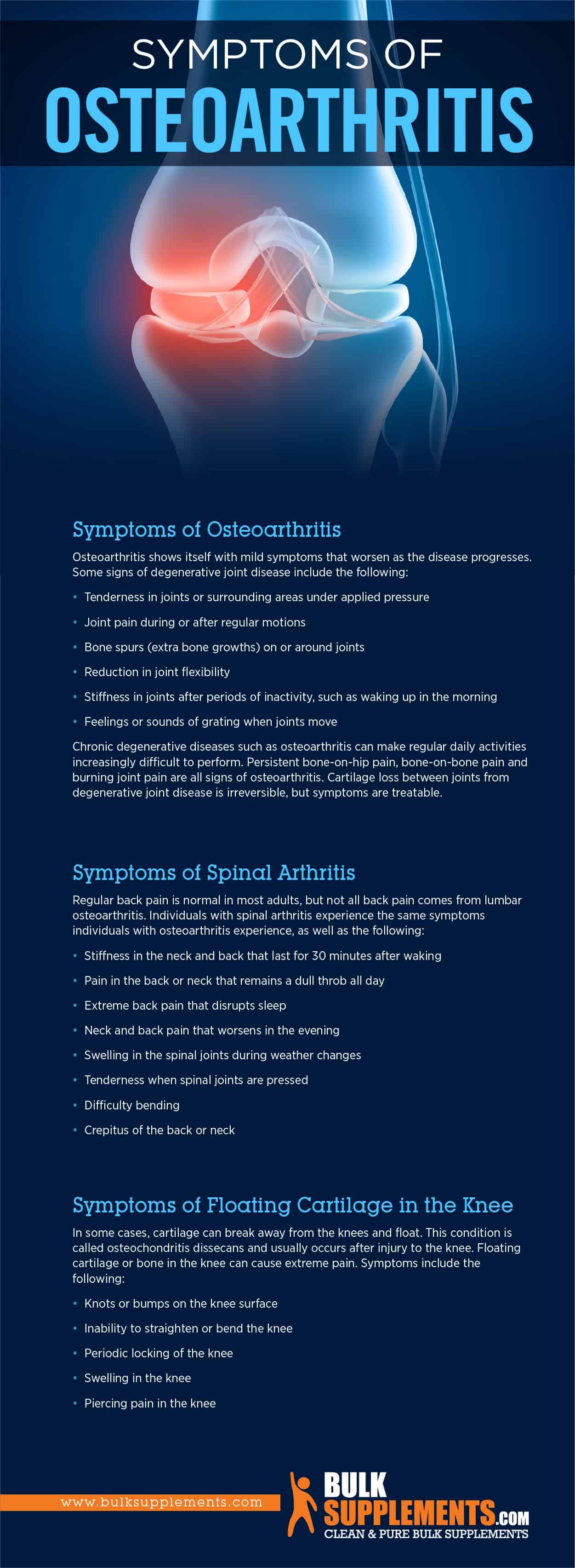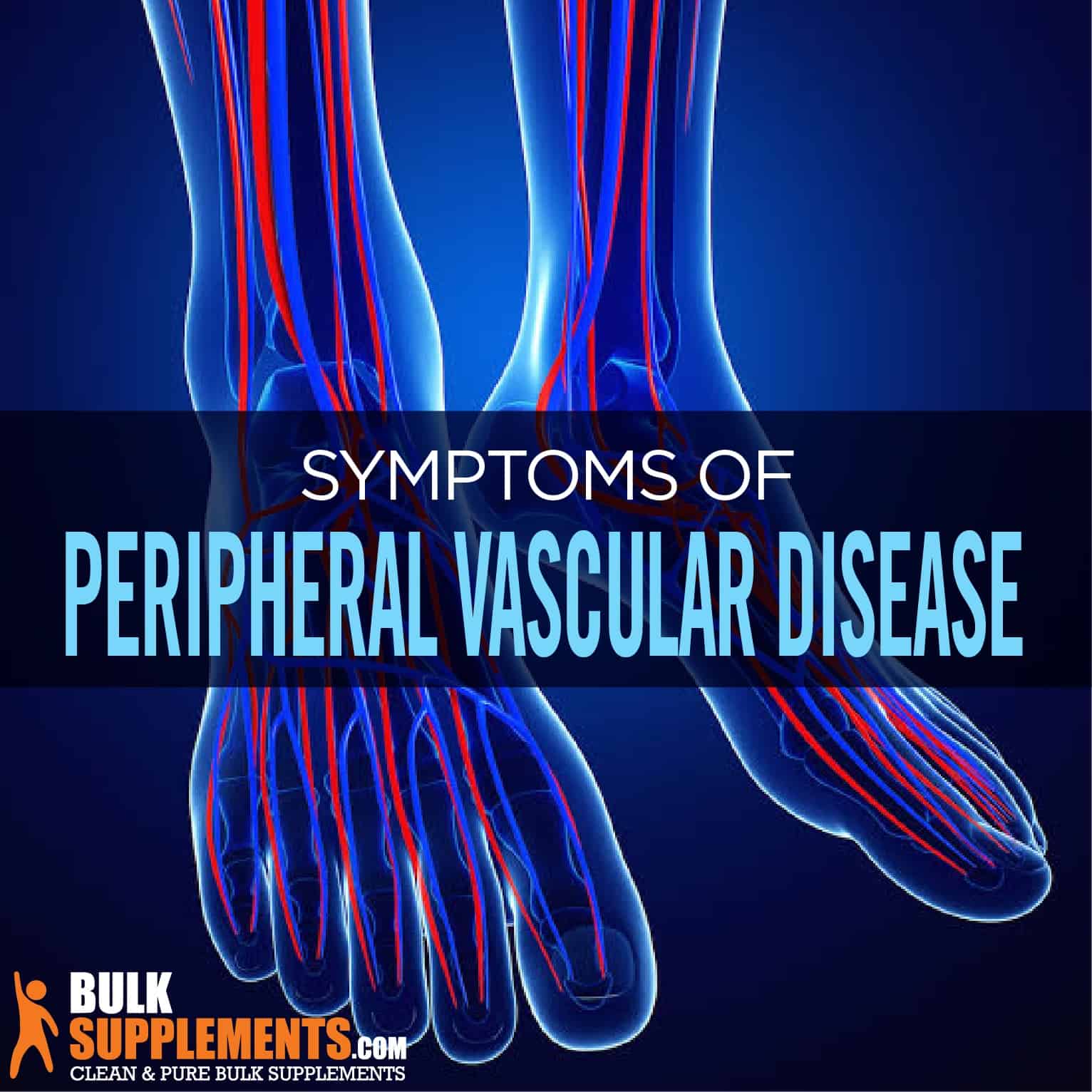Osteoarthritis: Symptoms, Causes & Treatment

Osteoarthritis
What is Osteoarthritis?
Osteoarthritis, also known as degenerative joint disease, is the most common form of arthritis. But what’s the difference between osteoarthritis and arthritis? Arthritis refers to joint inflammation whereas osteoarthritis refers to the breakdown of cartilage throughout the body.
Osteoarthritis mostly affects the weight-bearing joints — the spine, knees and hips. Though the condition can affect all joints, it usually won’t affect the toes, fingers and neck unless these parts of the body have sustained injury or been under excessive stress.
This disease affects more than 27 million Americans and many more around the world. As we get older, our chances of developing degenerative joint disease increase. Most people over 60 have minor osteoarthritis or other joint diseases. And though rare, it can also affect people in their mid-20s to early 30s.
There are many forms of osteoarthritis. Generalized osteoarthritis describes the condition if it affects three or more joints. Primary generalized osteoarthritis, however, describes the occurrence of stuffiness, pain and weakness in any joint of the body. And secondary osteoarthritis occurs as a result of injury rather than age or genetics.
Most chronic degenerative diseases affect bone or cartilage, of which there are a few main types in the body; the most common is hyaline. Hyaline helps you move, bend and stretch.
Osteoarthritis is treatable, but it’s irreversible and has no cure. The best way to prevent it or slow its progression is to stay active and eat a healthy diet.
Symptoms of Osteoarthritis
Osteoarthritis shows itself with mild symptoms that worsen as the disease progresses. Some signs of degenerative joint disease include the following:
- Tenderness in joints or surrounding areas under applied pressure
- Joint pain during or after regular motions
- Bone spurs (extra bone growths) on or around joints
- Reduction in joint flexibility
- Stiffness in joints after periods of inactivity, such as waking up in the morning
- Feelings or sounds of grating when joints move
Chronic degenerative diseases such as osteoarthritis can make regular daily activities increasingly difficult to perform. Persistent bone-on-hip pain, bone-on-bone pain and burning joint pain are all signs of osteoarthritis. Cartilage loss between joints from degenerative joint disease is irreversible, but symptoms are treatable.
Symptoms of Spinal Arthritis
Regular back pain is normal in most adults, but not all back pain comes from lumbar osteoarthritis. Individuals with spinal arthritis experience the same symptoms individuals with osteoarthritis experience, as well as the following:
- Stiffness in the neck and back that last for 30 minutes after waking
- Pain in the back or neck that remains a dull throb all day
- Extreme back pain that disrupts sleep
- Neck and back pain that worsens in the evening
- Swelling in the spinal joints during weather changes
- Tenderness when spinal joints are pressed
- Difficulty bending
- Crepitus of the back or neck
Symptoms of Floating Cartilage in the Knee
In some cases, cartilage can break away from the knees and float. This condition is called osteochondritis dissecans and usually occurs after injury to the knee. Floating cartilage or bone in the knee can cause extreme pain. Symptoms include the following:
- Knots or bumps on the knee surface
- Inability to straighten or bend the knee
- Periodic locking of the knee
- Swelling in the knee
- Piercing pain in the knee
Other Symptoms
Studies have shown that chronic fatigue affects many people who suffer from osteoarthritis. While it may not be a direct result of the disease, chronic fatigue may be a result of low quality of life, constant pain or even certain osteoarthritis treatments.
Osteoarthritis flare-ups are also common in those who have previously managed the condition (x). Sudden flare-ups can result from dietary changes, other lifestyle changes or medication. Flare-ups are usually temporary, and the condition usually normalizes once triggers go away.
Osteoarthritis muscle spasms can occur in those with advanced degenerative joint disease. Spasms can occur from weather changes, poor dieting or improper treatment.

Osteoarthritis Causes
Many factors contribute to the onset of osteoarthritis. Obesity, injury, age, heredity and birth defects can cause it. Individuals with rare genetic conditions such as osteogenesis imperfecta have a higher risk of developing degenerative joint disease.
These types of inherited diseases cause joint cartilage to break down much more quickly than in those without these diseases. People who suffer from scoliosis are prone to developing osteoarthritis in the spinal column as the condition progresses.
Obesity has a negative effect on many aspects of health. It can put extra pressure on the heart, increase blood pressure and increase the risk of diabetes. In addition, extra weight causes joints to wear down much faster than normal. Losing excess weight can prevent degenerative bone disease or slow down its progression.
Osteoarthritis can also develop from repetitive behaviors or injury. Athletes, for example, are more prone to developing the disease in their lower joints while people who work in manual labor are more prone to developing it in their upper joints. Injuries to certain parts of the body, such as the spine or a broken bone connected to a joint, can increase the risk of developing osteoarthritis later down the line.
Is Osteoarthritis Hereditary?
Heredity can play a part in the development of degenerative bone disease. People born with certain ailments such as dysplasia or Paget’s disease may be more prone to developing it. Most people who suffer from the disease also have older family members with it.
Living with Osteoarthritis
Living with degenerative joint disease isn’t easy. Managing the disease will require lifestyle changes (such as regular physical activity), workload changes and dietary changes; these changes can also slow its progression. There are four main stages of osteoarthritis, the last stage having severe effects on life quality. Advanced osteoarthritis may require more aggressive treatment and pain management than the disease’s earlier stages.
Some severe complications that can arise as a result of improperly managing the disease include chondrolysis, osteonecrosis and internal bleeding in the joints. These complications require surgery or other aggressive therapies to manage.
Alongside lifestyle changes, reliable support systems are vital to individuals living with the disease’s many frustrating complications. Osteoarthritis and stress aren’t a good mix, and extra stress can cause painful, debilitating flare-ups. Many assistive devices that can help take pressure off affected joints, such as knee braces and walkers, are available to buy. These devices will help manage pain, reduce stress and prevent painful flare-ups.
Remedies and Supplements for Osteoarthritis
Understanding the treatments available for degenerative joint disease will help you choose the best treatment options. Unless your doctor has prescribed it to you, before taking a supplement to treat degenerative joint disease, ask them whether that supplement is right for you. They may also have their own dose guideline for you to follow.
Prescription Treatments
Conventional medical treatments include pain relievers such as acetaminophen and anti-inflammatory medications such as naproxen or ibuprofen. Duloxetine also treats chronic pain from osteoarthritis. Doctors sometimes prescribe adjuvant topical treatments to relieve pain and swelling in joint areas. Although these medications can help manage pain, they won’t slow the disease’s progression.
Pure Boswellia Serrata Extract Powder
Boswellia serrata has many health benefits and few side effects. Boswellia serrata extract powder can help treat osteoarthritis, inflammatory bowel disease and rheumatoid arthritis by alleviating inflammation. It’s also a natural pain reducer and can prevent further cartilage loss. Take no more than 450 milligrams up to twice daily.
SEE ALSO

Peripheral Vascular Disease: Symptoms, Causes & Treatment
Pure White Willow Bark Extract Capsules
White willow bark has shown to reduce osteoarthritis pain. Take no more than 1,600 milligrams of pure white willow bark extract capsules once daily.
Methylsulfonylmethane
Studies have shown that methylsulfonylmethane has potent antioxidant and anti-inflammatory effects in the body. Its sulfur component can help the body produce glucosamine and collagen. For bone health, both are essential, which makes it an effective treatment for those suffering from osteoarthritis. Take two methylsulfonylmethane capsules up to three times daily.
Pure D-Glucosamine HCL Powder
Pure D-glucosamine HCL powder has shown in clinical research to alleviate mild joint pain from osteoarthritis. It’s an anti-inflammatory that can also support cartilage health. Take no more than 1,000 milligrams up to three times daily. Those allergic to shellfish should avoid taking this supplement.
Cat’s Claw Extract Powder
Recent studies have shown that cat’s claw extract powder is an effective natural alleviant for symptoms of rheumatoid arthritis and osteoarthritis. The supplement helps boost the immune system while inhibiting inflammatory activity in the body. Take 500 milligrams twice daily.
Before taking supplements to treat degenerative joint disease, be sure to talk to your doctor to determine which supplements are right for you. Follow their dose guidelines. If you’re unable to talk to a doctor about the correct dosage for a particular supplement, follow dose guidelines on the supplement packaging.
Other Treatments
Aside from prescription medications or supplements, other treatments are available to help you manage osteoarthritis. Heating pads and cold compresses are a great way to alleviate joint swelling and pain.
Physical activity can help combat the progression of osteoarthritis. To add, weekly sessions with a physical or occupational therapist can help you increase your range of motion and learn new ways to take stress off your joints.
Transcutaneous electrical nerve stimulation has shown to help reduce pain from osteoarthritis by numbing the nerves in the spinal cord. Physiotherapists perform this therapy, and its effects are temporary.
The Bottom Line
With a good support system in place and an effective treatment plan, living a healthy, happy life with osteoarthritis is possible — the disease doesn’t have to cause disability.
Physical exercise and healthy dieting will help you manage the disease much more effectively. Take care to be gentle to your joints since joint injury is much easier with osteoarthritis. Taking supplements such as cat’s claw extract powder can help slow the disease’s progression and alleviate the pain it causes.
Always remember that osteoarthritis won’t go away; you can only slow its progression and manage symptoms. Taking medications and supplements on time and as directed can help you maintain a healthy, active and relatively painless lifestyle.



